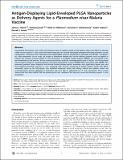| dc.contributor.author | Moon, James J. | |
| dc.contributor.author | Suh, Heikyung | |
| dc.contributor.author | Polhemus, Mark E. | |
| dc.contributor.author | Ockenhouse, Christian F. | |
| dc.contributor.author | Yadava, Anjali | |
| dc.contributor.author | Irvine, Darrell J | |
| dc.date.accessioned | 2012-06-14T19:17:56Z | |
| dc.date.available | 2012-06-14T19:17:56Z | |
| dc.date.issued | 2012-02 | |
| dc.date.submitted | 2011-10 | |
| dc.identifier.issn | 1932-6203 | |
| dc.identifier.uri | http://hdl.handle.net/1721.1/71155 | |
| dc.description.abstract | The parasite Plasmodium vivax is the most frequent cause of malaria outside of sub-Saharan Africa, but efforts to develop viable vaccines against P. vivax so far have been inadequate. We recently developed pathogen-mimicking polymeric vaccine nanoparticles composed of the FDA-approved biodegradable polymer poly(lactide-co-glycolide) acid (PLGA) “enveloped” by a lipid membrane. In this study, we sought to determine whether this vaccine delivery platform could be applied to enhance the immune response against P. vivax sporozoites. A candidate malaria antigen, VMP001, was conjugated to the lipid membrane of the particles, and an immunostimulatory molecule, monophosphoryl lipid A (MPLA), was incorporated into the lipid membranes, creating pathogen-mimicking nanoparticle vaccines (VMP001-NPs). Vaccination with VMP001-NPs promoted germinal center formation and elicited durable antigen-specific antibodies with significantly higher titers and more balanced Th1/Th2 responses in vivo, compared with vaccines composed of soluble protein mixed with MPLA. Antibodies raised by NP vaccinations also exhibited enhanced avidity and affinity toward the domains within the circumsporozoite protein implicated in protection and were able to agglutinate live P. vivax sporozoites. These results demonstrate that these VMP001-NPs are promising vaccines candidates that may elicit protective immunity against P. vivax sporozoites. | en_US |
| dc.description.sponsorship | United States. Dept. of Defense (contract W911NF-07-D-0004) | en_US |
| dc.description.sponsorship | Ragon Institute of MGH, MIT and Harvard | en_US |
| dc.language.iso | en_US | |
| dc.publisher | Public Library of Science | en_US |
| dc.relation.isversionof | http://dx.doi.org/10.1371/journal.pone.0031472 | en_US |
| dc.rights | Creative Commons Attribution | en_US |
| dc.rights.uri | http://creativecommons.org/licenses/by/2.5/ | en_US |
| dc.source | PLoS | en_US |
| dc.title | Antigen-Displaying Lipid-Enveloped PLGA Nanoparticles as Delivery Agents for a Plasmodium vivax Malaria Vaccine | en_US |
| dc.type | Article | en_US |
| dc.identifier.citation | Moon, James J. et al. “Antigen-Displaying Lipid-Enveloped PLGA Nanoparticles as Delivery Agents for a Plasmodium Vivax Malaria Vaccine.” Ed. Erika Martins Braga. PLoS ONE 7.2 (2012): e31472. Web. | en_US |
| dc.contributor.department | Massachusetts Institute of Technology. Department of Biological Engineering | en_US |
| dc.contributor.department | Massachusetts Institute of Technology. Department of Materials Science and Engineering | en_US |
| dc.contributor.department | Koch Institute for Integrative Cancer Research at MIT | en_US |
| dc.contributor.approver | Irvine, Darrell J. | |
| dc.contributor.mitauthor | Irvine, Darrell J. | |
| dc.contributor.mitauthor | Moon, James J. | |
| dc.contributor.mitauthor | Suh, Heikyung | |
| dc.relation.journal | PLoS ONE | en_US |
| dc.eprint.version | Final published version | en_US |
| dc.type.uri | http://purl.org/eprint/type/JournalArticle | en_US |
| eprint.status | http://purl.org/eprint/status/PeerReviewed | en_US |
| dspace.orderedauthors | Moon, James J.; Suh, Heikyung; Polhemus, Mark E.; Ockenhouse, Christian F.; Yadava, Anjali; Irvine, Darrell J. | en |
| dc.identifier.orcid | https://orcid.org/0000-0003-0787-298X | |
| mit.license | PUBLISHER_CC | en_US |
| mit.metadata.status | Complete | |
